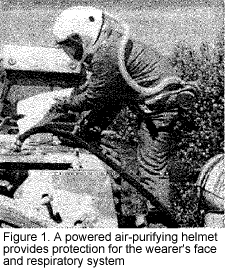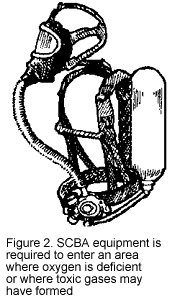Michigan farmers frequently work in areas laden with dust, molds and toxic gases that can damage their respiratory systems. Without proper protection, these farmers run the risk of developing a chronic illness that can rob them of their ability to work and enjoy life. In certain situations, such as in recently filled silos or in manure pits, even a brief exposure to the toxic gases can kill the unsuspecting farmer.
Matching the respiratory protective device with the situation is as important as selecting the right tool for the job. No farmer would attempt an engine overhaul with an adjustable wrench and pliers, so don:t count on a red bandanna tied around your mouth and nose to protect you when the situation requires a self-contained breathing apparatus similar to those worn by firefighters.
DISPOSABLE RESPIRATOR MASKS
The cost of these types of masks ranges from less than 25 cents to $6 each. There are disposable respirators available for pesticides, anhydrous ammonia, and livestock ammonia available in the $20 price range. These masks do not provide protection from fumigants.
Farmers can ensure that they are getting a respirator that will provide the required protection by reading the label which explains what type of particulates or vapors the masks are capable or removing.
CARTRIDGE RESPIRATOR SYSTEMS
 Available in prices ranging from $30 to $100, cartridge-type
respirators are capable of providing protection from anhydrous
and livestock ammonia, pesticides (but not fumigants), disinfectants,
dusts, molds, welding fumes, and acid and organic vapors.
Available in prices ranging from $30 to $100, cartridge-type
respirators are capable of providing protection from anhydrous
and livestock ammonia, pesticides (but not fumigants), disinfectants,
dusts, molds, welding fumes, and acid and organic vapors.
Farmers need to be aware that the cartridge respirator system is designed to filter out particulates and certain odors, they are not an air supply for oxygen deficient areas such as in sealed silos and manure pits, or in silos where silo gas is suspected.
Helmets are equipped with a rechargeable battery pack that can be plugged into the tractor:s electrical system for extended wear. The battery pack provides air flow for up to four hours so the farmer can leave the tractor to load or repair equipment.
The cost of an air-purifying helmet is about $700. Cartridge filters, which last about 100 hours and cost $30 to $45 per set, are available for pesticide and ammonia applications. The helmet does not provide oxygen to the wearer, it only filters out certain gases and particulates. The unit is not to be used in oxygen deficient areas such as sealed silos and manure pits, nor should it be used when applying fumigants.
SCBA
 The cost of the unit is about $1,600 and weighs about 45 pounds.
The user also needs to be instructed in proper use of the
unit.
The cost of the unit is about $1,600 and weighs about 45 pounds.
The user also needs to be instructed in proper use of the
unit.
FILTERS AND CARTRIDGE
Chemical Cartridge Elements Chemical cartridges are filled with a specially treated activated carbon that has a high absorption capacity to certain gases and vapors. As gases and vapors pass through the element they become trapped on the carbon element, stopping them from entering the mask. The absorption capacity of the cartridge is limited, so the wearer should replace the cartridge when any taste, odor or irritation is noticed.
Mechanical Filter Elements The mechanical filter protects the wearer from dusts and mists by trapping the particulates in the fibrous material of the mask. They become more efficient as the mask is worn, but the filter element must be replaced as it becomes more difficult to breath through.
FITTING THE RESPIRATOR
Banana oil ampules are available to test the fit of a respirator before entering an area with contaminated air. To test for proper fit, crush the ampules after installing the respirator, if any odor is detected then adjustments must be made to the respirator or new cartridges are needed.
MEDICAL CONCERNS
Michigan State University, Agricultural Engineering Department.
Howard J. Doss, Agricultural Safety Specialist; and William McLeod, Agricultural Engineering, Michigan State University Extension, East Lansing, Michigan 48862. 5/93. Funded by the National Institute of Occupational Safety and Health - #UO5/CC-4506052-02.
This information is for educational purposes only. Reference to commercial products or trade names does not imply endorsement by the MSU Extension or bias against those not mentioned.
Disclaimer and Reproduction Information: Information in NASD does not represent NIOSH policy. Information included in NASD appears by permission of the author and/or copyright holder. More